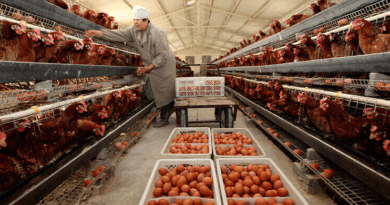Recommended Height of Deep Litter Poultry Pen and Cage Poultry Pen
The fundamental principle is that the poultry house should be high enough to allow for proper ventilation and also prevent heat. It should also be low enough to prevent the wind from demolishing it. However, the ideal height of pen in a deep litter system is 12 feet.
In the case of cages, the principle is the same. However, the building may be higher since cages will be placed inside it. The height may therefore be above 12 feet depending on the number of tiers of the cages that will be placed in it.
Poultry Deep Litter System
Deep litter is an animal housing system, based on the repeated spreading of straw or sawdust material in indoor booths.
An initial layer of litter is spread for the animals to use for bedding material and to defecate in, and as the litter is soiled, new layers of litter are continuously added by the farmer.
In this fashion, a deep litter bedding can build up to depths of 1–2 meters.
“The usual procedure for built-up floor litter is to start with about 4 inches of fine litter material with additions of 1 to 2 inches later as needed without removal of the old.
A depth of 6 to 12 inches is maintained by partial removals from time to time.” (Plamondon) Many consider this to be a natural means to disposing of animal feces.
“The deep litter cultivation is a modern ecological breeding technique based on decomposing feces by microbiological methods, a post processing method for poultry Manure.
Read Also: Poultry Housing Management: Poultry Pen/House Construction Guide
Advantages of Deep Litter System
1. It is an economical
2. Hygienic, comfortable and safe to birds
3. Built up litter supplies vitamin B12 and Riboflavin to the birds
4. Controls diseases and vices
5. It increases the efficiency of production
6. Materials such as paddy husks saw dust, dried leaf, chopped straw and groundnut kernels depending upon the availability can be used as litter materials.
Points to be considered while adopting deep litter system
1. The deep litter system should always kept dry.
2. Only right numbers of birds should be housed
3. The house should be well ventilated
4. The litter should be stirred at least once in a week-wet litter if any should be replaced immediately with new dry litter and birds must be fed a balanced ratio.
5. The time starting deep litter system should be in the dry period of the year as it allows sufficient time (At least two months) for bacterial action.
6. Placing of water should be given due attention to keep litter dry.

Poultry Battery Cage System
Battery cages are a housing system primarily recommended for egg-laying poultry. These feature arrangement of rows and columns of identical cages connected together, in a unit, as in an artillery battery.
They are semi-automated with drinking system, premium feeding system to avoid feed wastage, durable frames for the cages and good quality connecting fittings. The cages are categorized into
- Origin (imported or locally fabricated cages)
- Tiers (2, 3 and 4 tiers)
- Capacity (60, 90, 120 and 128 birds per unit)
- Mesh wire finishing (fully galvanized or semi-galvanized options)
- Feeder systems (PVC and aluminium feeding trough).
Advantages
1. Greater number of birds is reared per unit of area
2. Facilitates correct maintenance of records
3. Helps in identifying poor producers and prompt culling
4. Control of vices of poultry cannibalism and egg eating
5. It helps in production of clean eggs
6. Removal of stress factors
7. Easy control of parasitic disease like coccidiosis and worm infestation
8. Prompt steps to control feed wastage.
9. The cage method of housing is ideal for the area of moderated climate conditions where the day temperature in summer does not high and temperature does not fall too low.
10. Egg production of caged layer was reported to be more then those kept in deep litter system.
11. Feed efficiency and egg weight were better in caged birds than the laying flock under deep litter system.
Disadvantages
1. Difficulties in ensuring proper ventilation to birds especially in summer season and under very high densed conditions.
2. Incidence of leg problem, cage layer fatigue, fatty liver syndrome, flies and obnoxious gases in the house will be on increases
3. Hysteriosis of chicks
Related: How to Graft an Avocado Tree to Produce Avocado Fruit









